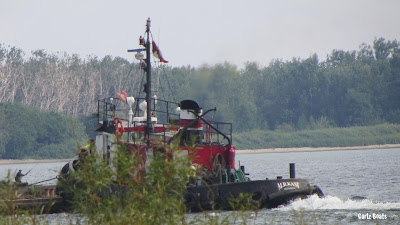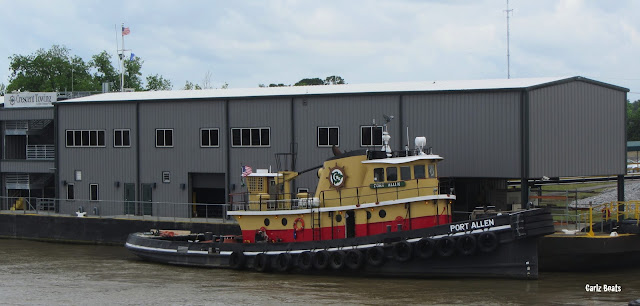Picked the right day on Monday to venture down to the Port of Montreal to checkout the winter layups. True it was quite cold in the wind which repeatly shut down my camera until I was able to shield in a pocket until I was ready to snap one off. Google Map directed me to Parc-du-harve near the roadway to the old EXPO '67 site from Kanata in 2 hours and 17 minutes nonstop. Though the concession stand and washrooms were closed, the park's shoreline outlooks offered a spectacular view of Montreal's downtown skyline, and most of all, a wonderful upfront array of boats snug and motionless at various piers and docks waiting for a new shipping season to begin but meanwhile easy prey for the my lens' taking. With so many laker's positioning systems shut off for the season, I wasn't completely certain what I was going to find, or how accessible were they going to be to photograph. I lucked big time because there in front of me was a girl I thought I'd never see again, the ALGOMA NAVIGATOR, (http://carlzboats.blogspot.ca/2015/03/self-unloader-algoma-navigator.html) bow outwards and looking pretty normal in a tattered and weathered kind of way with her name clearly on display and not painted over as expected. Perhaps her last voyage to the Turkish shipbreakers has been delayed for another season, or two? That would be nice.
Looking west I also captured a couple girls that I posted about a while ago, the Algoma bulker, TIM S. DOOL (http://carlzboats.blogspot.ca/2014/03/bulk-carrier-tim-s-dool.html) and CSL Trillium-class self unloader, BAIE ST. PAUL both bellied alongside each other. Further west along the Bickerdike basin wall were a few of new views for me, first two Desgagnés RO/RO carriers ANNA, and CAMILLA DESGAGNÉS and then the huge Seaway gate lifter VM/S HERCULES. Oh, when am I going to have the time to writes about these newbies, I thought.
To the east I recognised two of the three red hulled bulkers as CSL WELLAND and CSL ST. LAURENT followed by in the distance, the tanker THALASSA DESGAGNÉS and another gearless bulker, ALGOMA DISCOVERY.
The second surprise of the day came when I realized that the other red hulled vessel that was parked by the Molson beer distillery, was not a CSL but rather the recent Algoma acquisition and another that I had never seen before, the 646.5' ALGOMA INTEGRITY.
When the Panamax ocean-class self unloader was built in 2009 at the EISA shipyards in Rio de Janeiro her name was GYPSUM INTEGRITY and designed specifically to haul gypsum which is used to manufacture wallboard, from Hantsport or Little Narrow, in Nova Scotia to plants in the United States. During the U.S. recession, demand for gypsum declined so the INTEGRITY was reassigned to ocean trade duties primarily hauling iron ore from Sierra Leone. Though smaller in length to most of her fleetmates, ALGOMA INTEGRITY is 105' wide and therefore will never been seen in the Great Lakes due to the Seaway's maximum width requirement of 80'. Not a problem because since this wide body biggy was purchased by Alogoma Central Marine in 2015, she has only being used to haul iron ore from Port Cartier to the ArcelorMittel steel plant at Contrecouer, Quebec. Having ALGOMA INTEGRITY focus on this main run has freed ups other Algoma fleetmates to work other trades on the Great Lakes. Also, along with being wider than what we are used to seeing down here in this neck of the Seaway, ALGOMA INTEGRITY is also equipped with a 40 to 72 metre telescopic boom, which allows her to discharge up to 3,000 tonnes of cargo in an hour. Pretty impressive ship and capture. She's got what it takes and like her owner, she has INTEGRITY. c):-D

































